 |
|||||||||||||||
STORY LINK: Driving On Mars on Space Daily |
||
Driving on Mars — There's An App For That Using a "Scarecrow" to simulate martian surface exploration by Michelle Evans, July 2012
Upon entering the Land of Oz, Dorothy Gale met several creatures along the way who needed her help to find what they were missing. One of those, the Scarecrow, needed a brain. With the help of his friends and the great wizard this oversight was finally rectified.
In the magical world of the Jet Propulsion Laboratory in Pasadena, California, those in the Mars Exploration Program also have their Scarecrow. This one is a bit different than the straw man of Oz fame. Instead, it is a stripped down model of the Mars Science Laboratory, which lands on the Red Planet the evening of August 5.
The idea behind Scarecrow is to have an Earth analog to what the Mars Science Lab rover Curiosity might encounter on Mars. In the safety of an area at JPL named the Mars Yard, Scarecrow can test different techniques which then can be translated into commands for Curiosity. The reason Scarecrow got its name is it was originally never equipped with a brain of its own. It is also a bit spindly in nature, adding to the image of something which is definitely not human. This lankiness comes from the fact that Scarecrow has to weigh just 3/8ths as much as Curiosity, so when it moves on Earth, it has the equivalent weight to MSL on Mars. This equates to just 750 pounds compared to Curiosity’s one ton Earth weight.
Matt Heverly is a Mobility Systems Engineer at JPL, and was chosen on this mission for the important job as lead rover driver. This doesn’t mean he’s sitting behind a wheel or even a joystick to make Curiosity go on the martian surface. Matt told me, “I talk to kids every once in a while and they think, ‘You’re just like playing an Xbox, you’re driving the rover around like it’s a video game.’ The problem with that is the speed of light delay, so if I were to hit ‘forward’ on my joystick it would take seven to nine minutes at the range of our current orbit, for the command to actually reach Mars and start driving.”
This delay could make things tricky in a tight spot. Matt continued, “When you see a cliff coming in the distance, by the time you hit stop it’s seven minutes later when it sees the command, and by then it’s probably too late. So the way we really [drive] the rover is, every day we make a list of commands, a sequence we send to the rover. It wakes up in the morning and it says, ‘Oh, you want me to drive a meter forward and turn right a little bit, then drive another meter and deploy my robotic arm and take some samples and take these pictures.’ And it starts by driving a meter forward, goes through this list and does what we ask it to do. At the end of the Mars day it sends what’s essentially an email home with all this telemetry, and all the science results and pictures, and says, ‘Hey, I was successful in all these activities. I’m going to go to sleep now.’ While the rover sleeps overnight we plan what we want it to do the next day.”
With Scarecrow, they can make sure the rover is capable of traversing the territory chosen for the next martian day. Like with the actual rover, Matt does not use a joystick to drive Scarecrow about the simulated acreage. Instead he uses his iPhone. Matt explained, “An intern built an iPhone app for us, so I simply say I’m driving two meters forward and minus thirty degrees of heading change, then I hit ‘run’ and it should drive.” Matt demonstrated the process, and sure enough, Scarecrow took the incoming call and headed up and over a set of nasty looking rocks with its tubular wheels grinding away with nary a pause. Time used to be that a phone was simply used to talk to other people, and now we’re using them to teach rovers to drive on other planets.
But without a brain, and many of the other systems on the real rover millions of miles away, they also have a second rover at the Mars Yard as a duplicate in all ways to Curiosity. This allows exact commands to be checked and verified, not just the idea of moving safely amongst the martian rocks. This is what the scientists need for Matt and his rover driver team in order to get to the next spot they want to look at and sample. “The scientists say, ‘That rock over there is the best rock we’ve seen in a long time. I want to go over and explore it.’ Then it’s our job to safely build a sequence of commands to get to the rock so other people can deploy the robotic arm and find the sample [to] do the science we’re there to do on Mars.”
Simulating Mars on Earth has the primary difficulty in the weight differential. But that’s where Scarecrow comes in. In addition to the Mars Yard work, it can also be taken further afield. Matt said, “What we did was assemble a great group of scientists who help us find analogs here on Earth to what we expect to see on Mars. We just took Scarecrow out to the Mojave Desert where there’s wind-blown sand dunes, and we drove this rover all around in dunes formed by the same processes of how dunes form on Mars—the best analog we have here on Earth. We’re able to drive it around and characterize its performance to see what slopes we can go up, or if we get stuck can we get ourselves out. But it’s really hard to not have the whole system together, because this has to weigh on Earth what Curiosity will weigh on Mars. It doesn’t have a robotic arm, it doesn’t have cameras, it doesn’t have the autonomy, it doesn’t have the computer. So we have to do all these compartmentalized subsystem tests, then try to piece them all together.”
Of course, before Matt can drive on Mars, Curiosity still has the massive job ahead of getting safely to the surface. Matt shared his thoughts of what is to come in the late hours of Sunday, August 5. “I think putting a robot on Mars is really cool, but getting something onto the surface of Mars is a really hard problem. We have a tremendous amount of confidence in the team we’ve built out here at JPL, the engineering which was done, the testing we’ve done, but you can have a bad day on Mars. You can get a wind gust which makes it so you cannot land on the surface, and that’s outside of our control. We have tested an amazing amount, but we’ve never been able to test all of them coming together in Mars gravity, in an atmosphere as thin as Mars. When you put all the different pieces of the puzzle together there’s still a chance something’s not going to work out. I believe we’ve paid down the risk as much as we can and we’ve got a lot of confidence in it, but as I say, you can always have a bad day on Mars.”
While he waits for word that Curiosity, and thus his job, are still intact after landing, Matt continues to refine his work at the Mars Yard testing ground. The Curiosity engineering test model plugs away, as does Scarecrow. Matt has a lot of affection for Scarecrow, but as things get more complicated, he’s had to make changes to the six-wheeled creature to make sure it is up to the task ahead. As the great and powerful wizard in charge of his straw man, Matt admitted, “We recently gave it a brain, so we might have to change the name.” XXXX |
||||||||||||||||
Matt Heverly drives Scarecrow with his iPhone. |
The distinctive tread pattern of MSL. |
|||||||||||||||
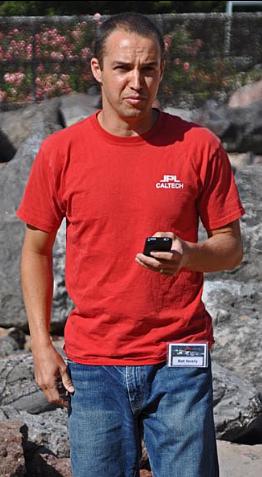 |
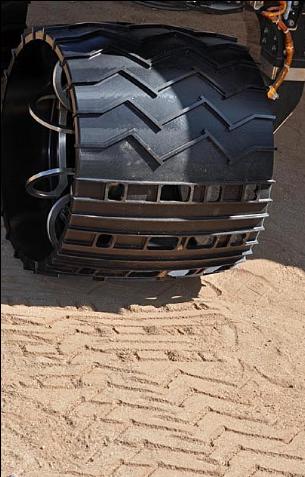 |
|||||||||||||||
Scarecrow being put through its paces. |
||||||||||||||||
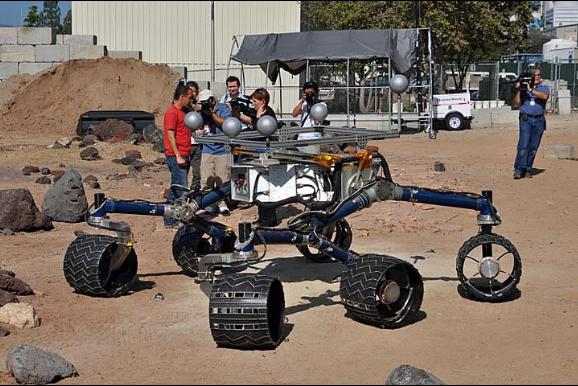 |
||||||||||||||||
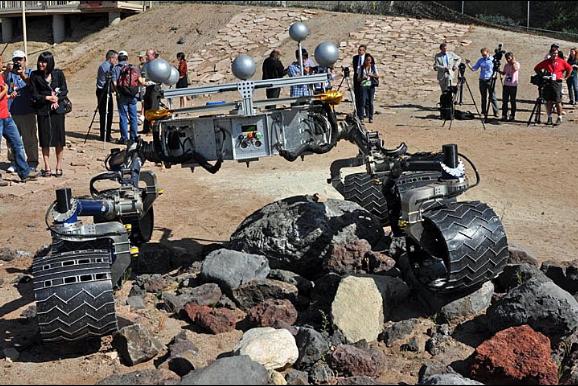 |
||||||||||||||||
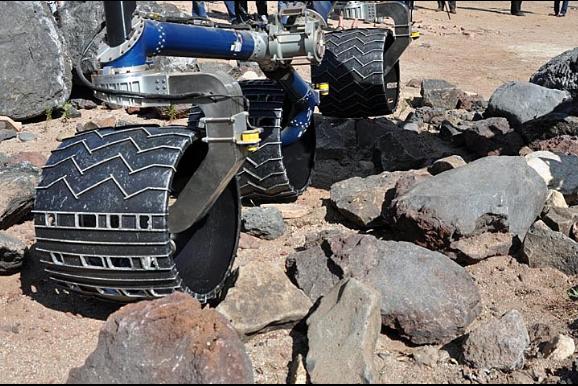 |
||||||||||||||||
The MSL engineering model starts a test drive. |
||
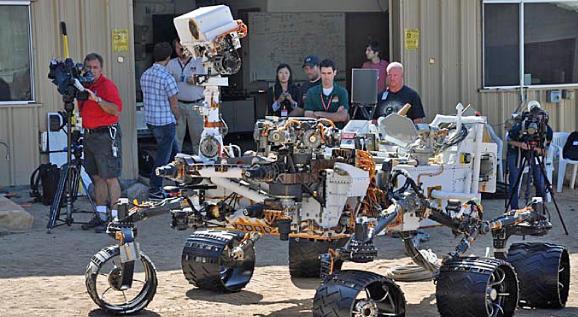 |
||
Scarecrow scaling the "Martian" heights. |
||
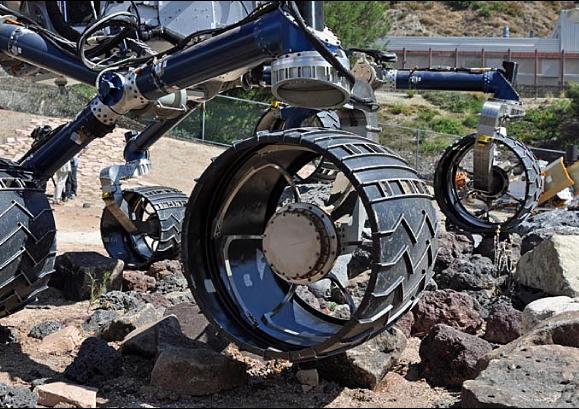 |
||
Sequence of photos which shows the flexibility of the wheel carriage to maneuver over rocks and obstacles. |
||
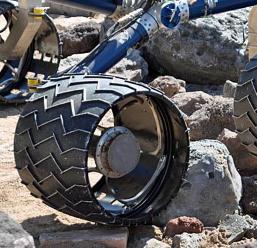 |
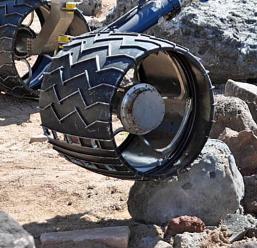 |
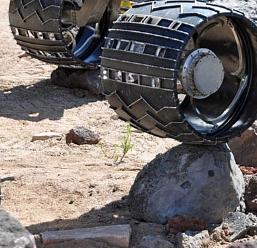 |
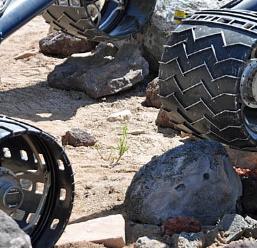 |
|||||
Scarecrow in the foreground and the MSL engineering test model behind. Both getting a good workout in the JPL Mars Yard on 25 July 2012. |
||
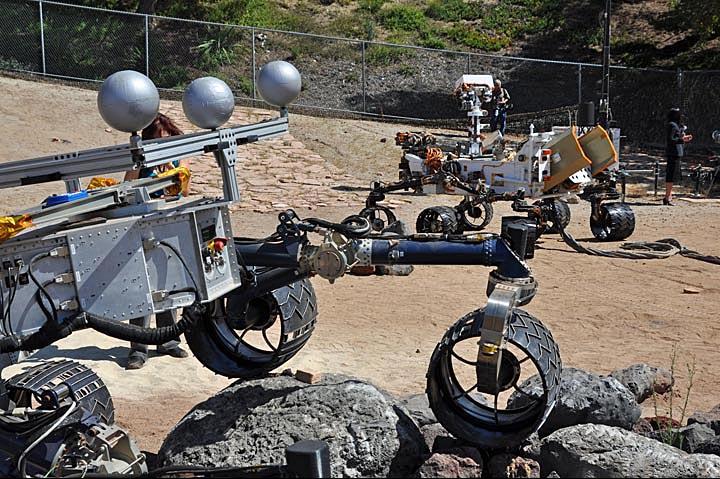 |
||